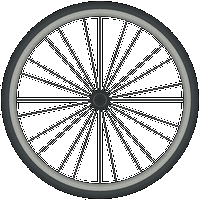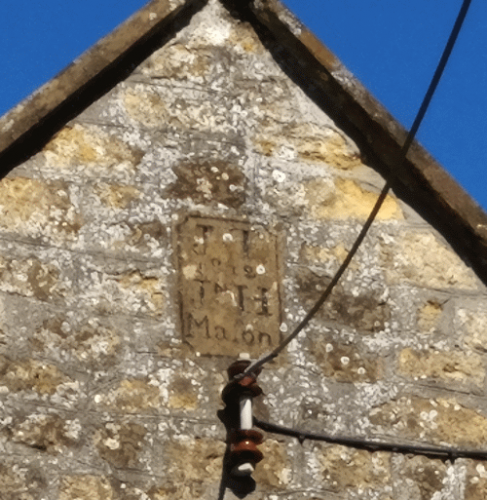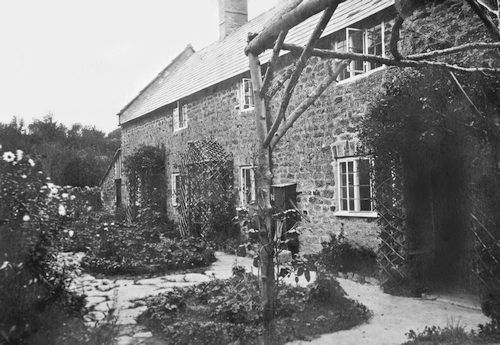James Sansome is the earliest recorded owner of this house but we don't know exactly when he owned it. He's mentioned in the copyholdType of feudal land tenure
with duties and obligations
to the Lord of the Manor Deed of Admittance granted to David Legg & Clement Davy on 11th May, 1827. Legg and Davy were the executors of John Trevett's will and the deed describes a dwelling house, outhouses, buildings, garden and orchard occupying approximately ½ acre "formerly in the tenure of James Sansome but late of John Trevett".
There is a date-stone high on the wall facing the road that appears to be inscribed "J T 1812 Jn H Mafon". It's possible that the initials J T stand for John Trevett and 1812 is the year he acquired the property. It is thought that James Sansome died in 1818 so the dates are feasible. The rest of the inscription would suggest Jn H was a mason who probably carried out some work on the building. There is a mason, John Hill, recorded as a father in the Netherbury Baptisms register at this time so he could be the mason in question but there is no hard evidence to confirm any of this conjecture.
John Trevett's will tells us that he owned several other properties in both Netherbury and Stoke Abbott. In 1827 his executors sold the house to Job Cox as part of their duties as trustees in order to divide Trevett's estate between his five children.
Job Cox was a local blacksmith who, according to the Tithe Apportionment of 1839, had a blacksmith's shop in Waytown on the site that is now occupied by The Hare and Hounds. Cox owned several other plots in that area - four houses and their gardens, four arable fields, two orchards and a withy bed.
In 1837 Cox sold this house to John Rawles and it is Rawles who is recorded in the Apportionment as the owner and occupier. The deed that records the transfer of the property notes that he paid £358 and that the messuageHouse or dwelling,
inc. outbuildings &
orchard, courtyard
or gardens was "now divided into four". Rawles was born in Bothenhampton in 1807 making him 30 years old when he bought the house. He'd married Mary Gilham, from Netherbury, four years earlier and by the time he bought the house they had two children. By the 1841 census the family has expanded to include four children and they've moved to North Bowood where the household includes two servants and John's occupation is recorded as Dairyman. Within a decade they'd moved again to Lower Broadenham Farm, now with seven children and John described as a Farmer.
In 1856 John sold the house in Netherbury to William Martin, a Salway Ash butcher, for £220 (a loss of £138). Not too much is known about William Martin. He was originally from Powerstock, occupied a house, garden and two adjacent fields in Salway Ash according to the Tithe Apportionment and he's listed as a Butcher in a couple of local directories in the 1850s.
We know the house had been divided into four by Job Cox some twenty years earlier and the Rawles family had presumably occupied one or more of those dwellings but they had moved out by 1841. 1856 is the first time we get a list of any tenants when they're named in the deed transferring ownership to William Martin as - Elizabeth Chard, John Hill, Abraham Warr & Henry Dobel and the same names appear as neighbours five years later in the 1861 census.
In that 1861 census William Martin is recorded as an Innkeeper and Butcher in Bridport but business doesn't seem too have gone well for him and by 1885 he owed £100 to William Read, a tailor with a shop in Netherbury. The house is valued at £105 and ownership is transferred to William & Elizabeth Read. The Deed of Surrender describes William Hine Martin as "out of business" and his address is given as being in South Kensington, London. Only six years later he's listed as an "Aged Inmate" of the Union Workhouse, Christchurch, Hampshire in the 1891 Census.
When William and Elizabeth Read take ownership of the house it has three tenants Ellen Hallett, Elizabeth Hallett, Henry Samson and “the other is unoccupied”. Just over seven years later the house was literally at the centre of "The Great Fire of Netherbury" when all the cottages surrounding it were destroyed in a disastrous fire that left eight families homeless and destroyed thirteen dwellings.
The building was spared from destruction because it had a slate roof, unusual for the time because nearly all ordinary houses were thatched. Thatch was the traditional and locally available roofing material. Slates and tiles were not produced locally and would have had to be transported making them expensive. Edward Taylor, a Master Thatcher from Chideock, when shown a photograph of Footfalls was certain it would have been thatched originally “those higher gables with water tables (stones on top of the walls) is a big give away".
Consequently the sparks from the initial chimney fire which started in George Watts' tenementRented dwelling
or land next-door and the embers from that thatch once it caught didn't set this roof on fire. The sparks and embers were carried on the wind, over the slate roof, and caught the thatch next-door belonging to the house (now Virginia Cottage) which, at the time, was the home and bakery of George Hodder. From there the fire spread over St James Road and destroyed three cottages that stood on the plot that now contains the Bowdowns terrace. It also consumed two unoccupied cottages on the north-western corner of the junction with Hingsdon Lane.
William Read died on 29th September, 1912 and Elizabeth obtained the freehold in her own name five years later. At this time she appeared to be living at the house alongside long-standing tenant Ellen Hallett and a third tenant simply described as Major with no first name. Three days earlier Elizabeth had been granted a certificate declaring that full Estate Duty had been paid on the property which listed the occupants as Ellen Hallett, Alfred Paul and Robert Major.
A fortnight after she'd gained the freehold on the property Elizabeth sold it for £200 to John Hunt from Seven Kings, Essex. The tenants listed on the Conveyance are Ellen Hallett, Elizabeth Read, Sarah Ann Major and one unoccupied. This document also identifies the property as Plot No. 642 on the Tithe Map for the first time.
Hunt, an engineer, seems to have converted the building from four dwellings into two and by 1921 Ellen Hallett is the only remaining tenant when he sells it on to Mary Bignall from Bromley, Kent for £450. He retains a financial interest becoming the mortgagee of a loan for £250 secured by the property. Mary Bignall gives the house the first name we have on record - "Friedenheim" which can be translated from German as meaning "home of peace".
Ellen Hallett was a long-term and long lived tenant. She's named in various deeds from 1885 to 1921 but examination of the census returns suggests she was probably living there in 1881. She died in 1930 at the age of 94 and is buried in the Netherbury graveyard. Although the last record we have of her at the property is in 1921, it's possible that she lived there until she died as it was not until later that year that Mary Bignall sold it. If that was the case the property could then have been sold with both dwellings empty opening up possibilities for the new owner and that may have triggered the sale at this point.
In September of 1930 Mary sold Friedenheim to Fanny Dorr from Broadstairs, Kent, for £300, paying off the £250 mortgage. A couple of months later Fanny had the property valued with the aim raising a mortgage of £200. The valuation states that she plans to spend £150 converting the cottages into one dwelling and suggests that "when done would represent a fair security for the advance of £250".
In January of the following year, 1931, Fanny sells on the "MessuageHouse or dwelling,
inc. outbuildings &
orchard, courtyard
or gardensHouse or dwelling,
inc. outbuildings &
orchard, courtyard
or gardens formerly divided into four dwellings (now one dwelling)" to Samuel Goodger of Harrow, Middlesex, for £350. At some point Goodger renames the house "Sunnymead" and in July, 1940, sells it to Annie Laurie for £850. She, in turn, renames it "Old Footfalls" and five years later sells it to Joan Lawe for £2000. It remained "Old Footfalls" until at least 1979 when it was bought by Robert and Penelope Fisher.



